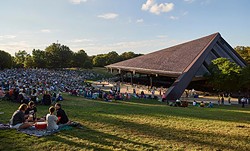Saving the most popular music for last is an old, transparent gambit designed to keep concertgoers from fleeing at intermission. Last night at Blossom, the Cleveland Orchestra also saved its best playing for after the break.
Tchaikovsky’s Piano Concerto No. 1 made up the first half of the program. Throughout the concerto, the orchestra was atypically reticent. Maybe they were afraid of overpowering the young Uzbek pianist Behzod Abduraimov, who actually didn’t need any help projecting a clear, robust sound in the pavilion.
Abduraimov’s performance was grounded and mature. He took absolute pleasure in the second movement’s Prestissimo interjection, performing the offbeat, twittering chords and rapid runs with total precision and lightness. Before the cello solo in the same movement, the descending pitter-patter of Abduraimov’s chords brought to mind the delicate woodwind passages of the “Danse des Mirlitons” from The Nutcracker. In the slow outer sections of the second movement, the strings could have been more lush.
The first movement cadenza was remarkably cohesive. Pianists tend to be overly aggressive with the accelerando contrary-motion octaves that interrupt fragments of the second theme. In Abduraimov’s rendition, the octaves were not interruptions at all, but tasteful digressions that effectively fed the music’s forward trajectory. The clarinet solo following the first woodwind murmurs of the doleful second theme was gorgeous, soaring and plaintive.
The concerto’s final movement was snappy. But again, the violins held back and melodic peaks unfortunately deflated in the soggy pavilion air.
The orchestra, having saved its energy during the concerto, was far more committed to Tchaikovsky’s Symphony No. 5. The plodding quality of Tchaikovsky’s main theme typically begets lumbering interpretations, but it was helped along by conductor Robert Trevino’s tempos, which skewed fast and gave the music a much-needed edge. The third movement was slightly too fast, though. The reeds struggled to keep up.
Trevino led the orchestra through the piece without any breaks between movements. The opening of the second movement might have benefited from a slight pause beforehand, but the smooth harmonic motion between the movements made the transition feel natural. The third movement took on a slight darkness, as the orchestra didn’t have a moment to shake off the second movement’s pathos. Overall, the nearly continuous playing was captivating.
The strings, though much more enthusiastic, were far too quiet in the second movement. The horn solo sounded timid and out-of-place, perhaps because it was hung out to dry by a barely audible accompaniment. The horn’s countermelody during the cello soli was more intrusive than complementary.
In fact, balances were problematic at several points in the symphony. From where I sat, the second movement’s loud climaxes needed more bass and warmth. Instead, the high points became bright, featureless washes of sound. Several times in the fourth movement, chugging cellos and basses overpowered woodwinds playing in their lower registers.
The fourth movement’s trick ending worked marvelously on last night’s audience, though it’s no secret Cleveland audiences will applaud anything that ends loud and fast. After the booming chord posing as the symphony’s end was cut off, a lone clap rang through the pavilion. Trevino’s face registered a playful smirk, and the orchestra played on toward the symphony’s much more spectacular, real ending.


